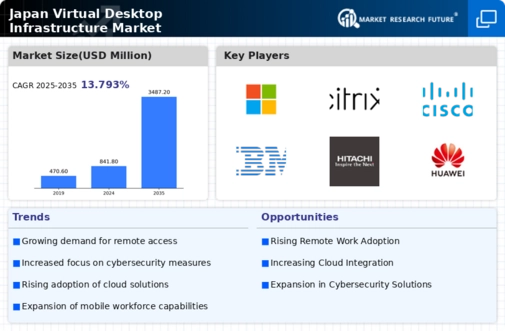Growing Cybersecurity Concerns
Cybersecurity remains a paramount concern for organizations in Japan, influencing the virtual desktop-infrastructure market. With the increasing frequency of cyber threats, businesses are compelled to adopt robust security measures to protect sensitive data. Virtual desktop solutions inherently provide enhanced security features, such as centralized management and data encryption, which are appealing to organizations looking to mitigate risks. Recent surveys indicate that over 70% of Japanese companies consider data security a top priority when selecting IT solutions. This heightened focus on cybersecurity is likely to drive the adoption of virtual desktop infrastructures, as they offer a secure environment for remote access and data management, thereby reinforcing the market's growth trajectory.
Increased Focus on Cost Efficiency
Cost efficiency remains a critical driver for the virtual desktop-infrastructure market in Japan. Organizations are increasingly seeking ways to reduce IT expenditures while maintaining high levels of performance and security. Virtual desktop solutions offer a compelling value proposition by minimizing hardware costs and simplifying management processes. According to industry estimates, companies can save up to 30% on IT costs by transitioning to virtual desktops. This financial incentive is particularly appealing to small and medium-sized enterprises (SMEs) that may have limited budgets for IT infrastructure. As businesses continue to prioritize cost-effective solutions, the virtual desktop-infrastructure market is likely to see sustained growth, driven by the need for efficient resource allocation and operational savings.
Rising Demand for Remote Work Solutions
The virtual desktop-infrastructure market in Japan is experiencing a notable surge in demand for remote work solutions. As organizations increasingly adopt flexible work arrangements, the need for secure and efficient remote access to desktop environments becomes paramount. This shift is reflected in a reported growth rate of approximately 15% in the adoption of virtual desktop solutions among Japanese enterprises. Companies are recognizing the benefits of virtual desktops in enhancing productivity and collaboration while reducing operational costs. Furthermore, the ability to provide employees with seamless access to applications and data from any location is driving the expansion of the virtual desktop-infrastructure market. This trend is likely to continue as businesses seek to optimize their workforce management strategies and improve employee satisfaction through remote work capabilities.
Integration with Artificial Intelligence Technologies
The integration of artificial intelligence (AI) technologies into the virtual desktop-infrastructure market is emerging as a significant driver. AI capabilities can enhance user experience by automating routine tasks, optimizing resource allocation, and providing predictive analytics for performance management. In Japan, where technological innovation is highly valued, the incorporation of AI into virtual desktop solutions is likely to attract considerable interest from enterprises. Reports suggest that the AI market in Japan is projected to grow by 20% annually, which could positively influence the virtual desktop-infrastructure market as organizations seek to leverage AI for improved operational efficiency. This synergy between AI and virtual desktops may lead to more sophisticated solutions that cater to the evolving needs of businesses.
Government Initiatives Supporting Digital Transformation
The Japanese government is actively promoting digital transformation across various sectors, which significantly impacts the virtual desktop-infrastructure market. Initiatives aimed at enhancing IT infrastructure and encouraging the adoption of cloud technologies are creating a conducive environment for virtual desktop solutions. For instance, the government has allocated substantial funding to support technology upgrades in public and private sectors, which is expected to boost the market. Reports indicate that investments in digital infrastructure could reach ¥1 trillion by 2026, further stimulating demand for virtual desktop solutions. This governmental push not only facilitates the transition to virtual environments but also encourages businesses to innovate and adopt modern IT practices, thereby propelling the growth of the virtual desktop-infrastructure market.

















Leave a Comment